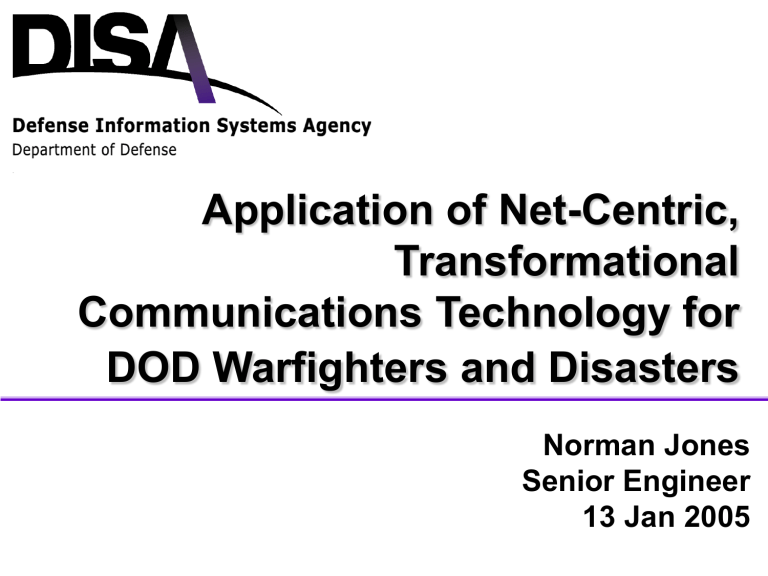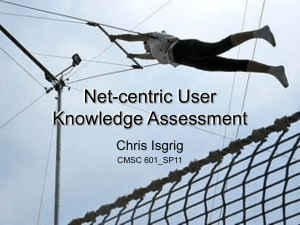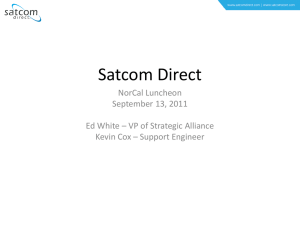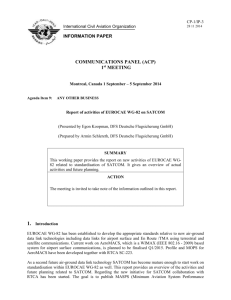Application of Net-Centric, Transformational Communications Technology for DOD Warfighters and Disasters

Application of Net-Centric,
Transformational
Communications Technology for
DOD Warfighters and Disasters
Norman Jones
Senior Engineer
13 Jan 2005
Purpose and Overview
• Provide an overview of
– Evolutionary Implementation of
Transformational Communications
• Based upon Net-centric technology using Everything over IP (EoIP)
• Initial focus is on support to DOD deployed warfighters
•
Comparable technology has been, applied to natural disasters
• Net-centric technology lends itself to
“Swords into Plowshares” chaotic situations such as disasters
• Caveat: this is for informational purposes and is not intended as an indication of DISA policies
DISA Support of Customers 2
Evolutionary Implementation of
Net-Centric,Transfmt Comms
• Transformational Communications include long term systems (e.g., Transformational Satellites) with progress accomplished in evolutionary fashion
•
Provide interim capabilities in near term while ensuring consistency with long term architectures
• A Key aspect is a partnership with the military
Services/COCOMs/agencies
• Example: Net-centric technology being used to support Iraq operations
• Leverage upon DISA systems
• Show a way ahead for evolutionary implementation into operational environment
Net-Centric Communications Using EoIP 3
Migration to Net-Centric
Comms Over SATCOM
Trends:
IPv6 Policy
IP-based Apps
Commercial IP Modems
Convergence Routers
Today’s
Transponded
SATCOM
IP
SATCOM
IP
IP Modem Std
JTRS
Far-term
Processing
SATCOM
IP
SCPC modem
Serial Trunk
Dedicated PTP circuits
IP Net IP Net
-Multi-access packet-based
IP
-Shared DAMA circuits
IP Net
IP Net
- IP-routing on-board
- Transformational
Satellites
4
Evolutionary TC Architecture Based
Upon EoIP
SATELLITE SYSTEMS
Unclas networks IP-Based
Applications &
Services
IP-Based
Applications &
Services
IP phone/STE
IP Phone/softphone
Classified networks
Global
Information
Grid/Defense
Information
System
Network
IP SATCOM
Modem/Router
VTC
IP SATCOM
Modem/Router
DISN/GIG Deployed Warfighters
Service, Agency, Combatant Command
Net-centric Enterprise
Services (NCES),
Defense Collaboration Tool
Suite, etc.
5
Approach for Transformational
Communications
Leverage upon GOTS and
COTS
Achieve progress in increments
Cooperative partnership with COCOMs, military
Services and agencies
The grade for almost succeeding at the elegant solution is F-
Exercise/demo to assess technology and ensure operational viability
6
IP Network Management
• Traditional SATCOM based upon serial interface
FDMA/SCPC involves M&C of discrete, nailed up
SATCOM links
• IP SATCOM modems include routing functionality for BW on demand and use a central controller which has oversight of all the deployed modems in the network
– Controller has real time monitoring and control over the modems
• The network operations centers can have visibility into SATCOM operations
– Real time and historical performance data
• Consolidated control of voice/data/video convergence router and IP modems is possible
• Advantage for disasters: deployed operator’s tasks are greatly simplified
7
M&C
IP SATCOM Modems
• Traditional muxes/modems are circuit based with TDMs and serial interface SATCOM modems
– Circuits over nailed up SATCOM links
• Transformational Comms/EoIP approach can use routers and IP modems and Defense Information System Network
– Router to process converged voice/data/video user traffic
– SATCOM modem with IP interface
• Embedded security aspects
•
Centralized management for simple deployed operations
– Efficient use of scarce, expensive space segment by providing bandwidth on demand over SATCOM
– Simplify operations by EoIP
– Seamless Global Information Grid (GIG) interface
Circuits/TDMs Nailed-up SATCOM
Links
8
Test Results and Plans
• Two purposes:
– Verify that the technology is operationally viable
– Maintain partnership with the users/military
Services
• DISA, others conduct tests in the lab to assess technology
• Follow on tests are conducted in a partnership with the military Services
– Test in operational type environment as part of military Service test/exercise
9
Example of Recent Military Test
Using EoIP
Military test which partly morphed into communications support for hurricanes
10
QOS for IP based Technology for
Deployed Warfighters
• Migration to packet technology requires fulfillment of warfighter attributes
– Traffic can have different priorities and attributes
• Priority/QOS required for effective use of the SATCOM WAN and support user traffic properly
• Need assured service for high priority traffic
• Lower priority user traffic should be able to use whatever capacity remains on the SATCOM (or other) BW constrained WAN
• Use of DSCP can be part of the approach
• Jones axiom: when IP was created, it was sufficient to deliver most of the packets, eventually, in some order
11
Real Time Services/VoIP
• DISA collaborating with other organizations on
Real Time Services
• VoIP is a main area
– Prioritization/assured service is a primary topic
• No point in doing VoIP without doing EoIP
12
DISA Collaboration with Other Organizations including
Support of Disasters (e.g., hurricanes), Next 911
Capitalize upon Net-centric, transformational communications technology
13
National Guard Configuration
National Guard communications suites of multiple states were deployed to support hurricanes (initially Katrina, then Rita). DISA provided systems engineering and
DISN/Teleport interfaces.
Texas National
Guard Comms at Superdome
14
National Guard Concept
WMD Unified Command Suite
15
GBS Support to JTF-Katrina
Efforts
• DISA, in conjunction with the Global Broadcasting Service
(GBS) Joint Program Office (JPO), provided communications support. Leverage upon DVB-RCS
16
Red Cross Deployed Comms Suite
• Red Cross also fielded net-centric comms suites
• Equipment configuration similar to USNORTHCOM,
DOD in Iraq, and others
Red Cross and DISA people and comms suite
17
Transformational, Net-Centric
Comms Capability Summary
• Capitalizing upon net-centric, transformational communications allows effective, flexible support of user communities
•
Various types of traffic (e.g., voice/data/video) can be combined and processed in routers/IP according to the dynamics and priorities of the traffic
• Highly suitable for ad hoc, dynamic situations
•
Less preplanning is required than with traditional circuitbased technology
• Comparable net-centric technology could apply DOD or other users in disasters where responsive communications is essential
• Technology will evolve, work/refinements remain, but no apparent “fatal flaws” in EoIP
Responsive Communications in Crisis 18
www.disa.mil





